
- What We Know About Aikido
- What We Know About Taekwondo
- Key Elements Of Aikido
- Key Elements Of Taekwondo
- Aikido Rankings & Levels
- Taekwondo Rankings & Levels
- Aikido Vs. Taekwondo Attire
- What A Typical Aikido Training Session Looks Like
- What A Typical Taekwondo Training Session Looks Like
- Aikido Movies
- Conclusion: Aikido Vs. Taekwondo
Many people in the martial arts community debate whether Aikido or Taekwondo is the better practice. While both offer unique benefits and principles, there are some key differences that set them apart.
The main difference between Aikido and Taekwondo lies in their ippon, or core principle. Aikido is a non-aggressive martial art that focuses on redirecting the energy of an attack and using it against the attacker without inflicting harm.
Taekwondo, on the other hand, has a more aggressive focus and involves striking techniques aimed at incapacitating an opponent.
Another key distinction is the way each martial art is practiced. Aikido involves throws, joint locks, and pins, while Taekwondo involves kicks and punches.
In terms of physicality, Aikido involves more dynamic and physically demanding movements. Taekwondo promotes agility and strength through repetitive kicking drills.
While both martial arts offer self-defense skills, Aikido places a greater emphasis on conflict resolution and avoiding violence altogether. Taekwondo, on the other hand, may have more practical applications for defending oneself in real-life situations.
Those are the main differences between Aikido and Taekwondo, but if you want to learn more, I've broken down their ranking systems, benefits and even top movies featuring each art below!
What We Know About Aikido
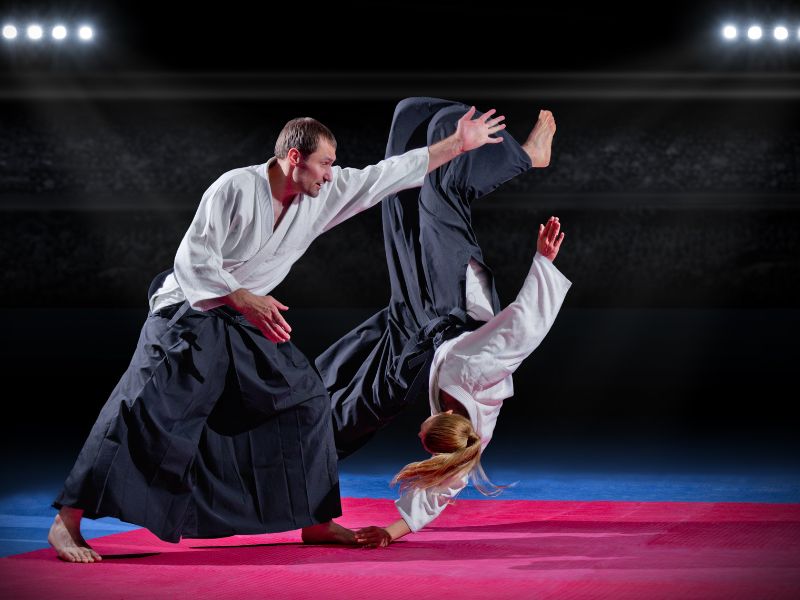
Aikido is a modern martial art that was created in the early 20th century by Morihei Ueshiba. It is based on the principles of budo, which follows the code of ethics of bushido.
Bushido is the code of ethics that samurai follow and teaches justice, courage, benevolence, politeness, honesty, honor, and loyalty.
Aikido is a combination of aikijujitsu, which is a martial art that uses both unarmed and armed fighting techniques, and iai-jutsu, which is a martial art that uses swordsmanship.
Aikido employs unarmed techniques, such as strikes, joint locks, and throws to subdue an opponent. It also makes use of weapons such as knives, swords, and sticks to defend against an attacker.
Aikido practitioners believe that one should only use the amount of force necessary to achieve their goals.
They also believe in using an opponent's momentum against them in order to control them rather than harm them.
Aikido is a challenging but rewarding martial art to study. It requires hefty discipline and dedication to master its techniques.
Thankfully though, the rewards are great for those who persevere, especially since Aikido can provide its practitioners with a sense of confidence and inner peace. It can also teach them how to better defend themselves and others in dangerous situations.
What We Know About Taekwondo
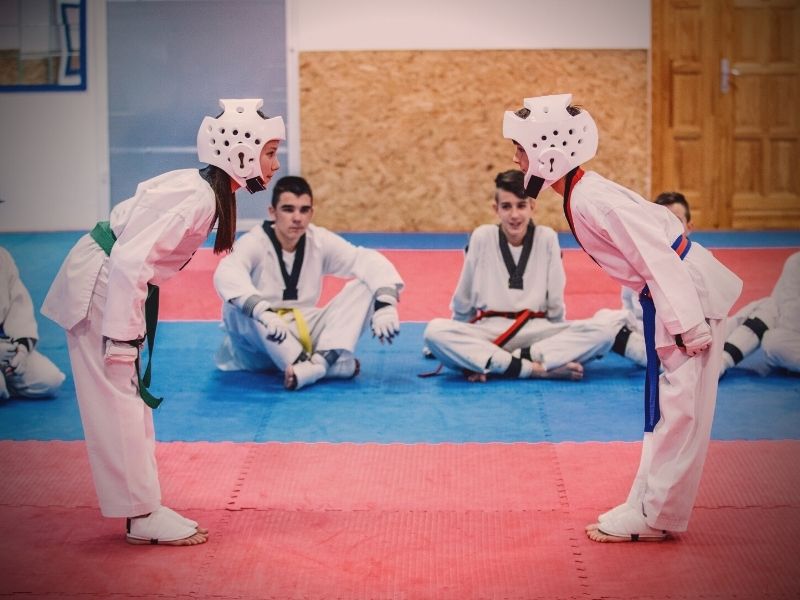
Taekwondo is a Korean martial art that emphasizes kicking and punching techniques. It is one of the most popular martial arts in the world, with millions of practitioners worldwide.
Taekwondo is often practiced as a sport, but it can also be used for self-defense. The word “taekwondo” literally means “the way of the foot and fist.”
Taekwondo is characterized by its fast and powerful kicks. Although it's a fairly recent martial art, it is believed to have roots in the ancient tribes of Korea, who used it for hunting and combat.
Taekwondo was formalized as a discipline in the 1950s, and it has since spread to many other countries.
There are four main styles of Taekwondo: Traditional, World Taekwondo, ITF, and ATA style. Taekwondo competitions are governed by the World Taekwondo Federation (WTF), which sets the rules for sparring and other aspects of the sport.
Taekwondo training typically includes a combination of physical conditioning, technique drills, and sparring.
Students usually progress through a series of colored belts as they learn and master new techniques. The black belt is the highest rank in taekwondo, and achieving this rank requires dedication and hard work.
Whether you’re interested in taekwondo for sport, self-defense, or simply as a way to stay fit, this martial art can be an enjoyable and rewarding experience. With its emphasis on kicking techniques, taekwondo is unique among martial arts, and its popularity continues to grow around the world.
Of course, this is only a brief history and understanding of Aikido and Taekwondo, but if you want to go deeper into either art, be sure to check out the following posts:
Now, back to the comparison...
Let's look at the origins of the respective disciplines and then compare the key elements of their practices. You will be able to understand some of their similarities and differences a bit better afterward.
| Aikido | Taekwondo | |
| Origins | Japanese | Korean |
Key Elements Of Aikido
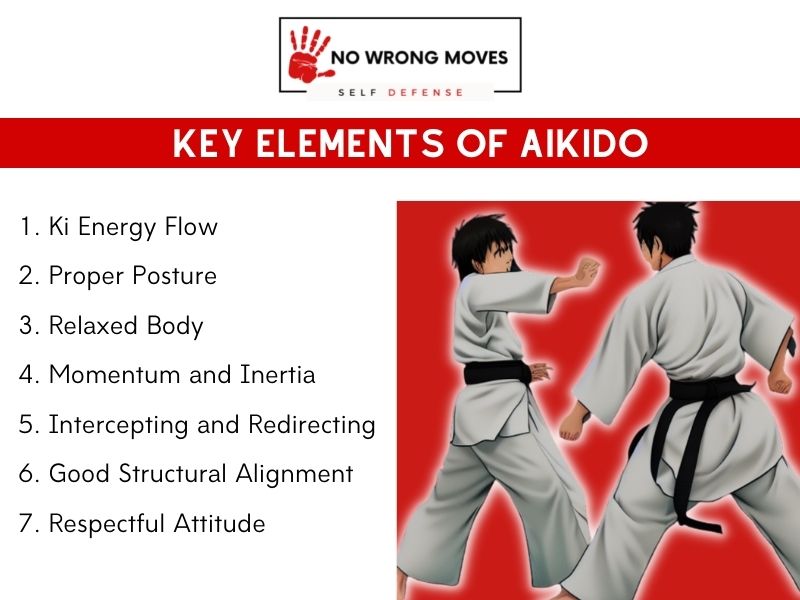
Aikido is a Japanese martial art that focuses on the proper stance and balance of the practitioner. Proper stance and balance are critical components of Aikido, as they provide the foundation for all other techniques.
A stable and balanced stance allows the practitioner to move fluidly and with control, making it easier to perform techniques effectively.
In Aikido, practitioners learn to redirect their opponent's energy rather than using force against them. Redirecting energy is one of the fundamental aspects of Aikido, and it's difficult to separate this idea from the sport itself.
Through properly redirecting an opponent's energy, Aikido practitioners can use their opponent's momentum against them, rather than relying on their own strength.
Apart from physical techniques, Aikido also emphasizes controlling one's emotions. Practitioners learn to remain calm and focused, even in stressful situations.
Aikido also places a strong emphasis on non-violent conflict resolution. The first option in any situation is to find a peaceful resolution, rather than resorting to violence.
Remember that in Aikido, the first option is not violence, and it reflects the overall philosophy of Aikido as a martial art focused on peace and harmony.
Key Elements Of Taekwondo
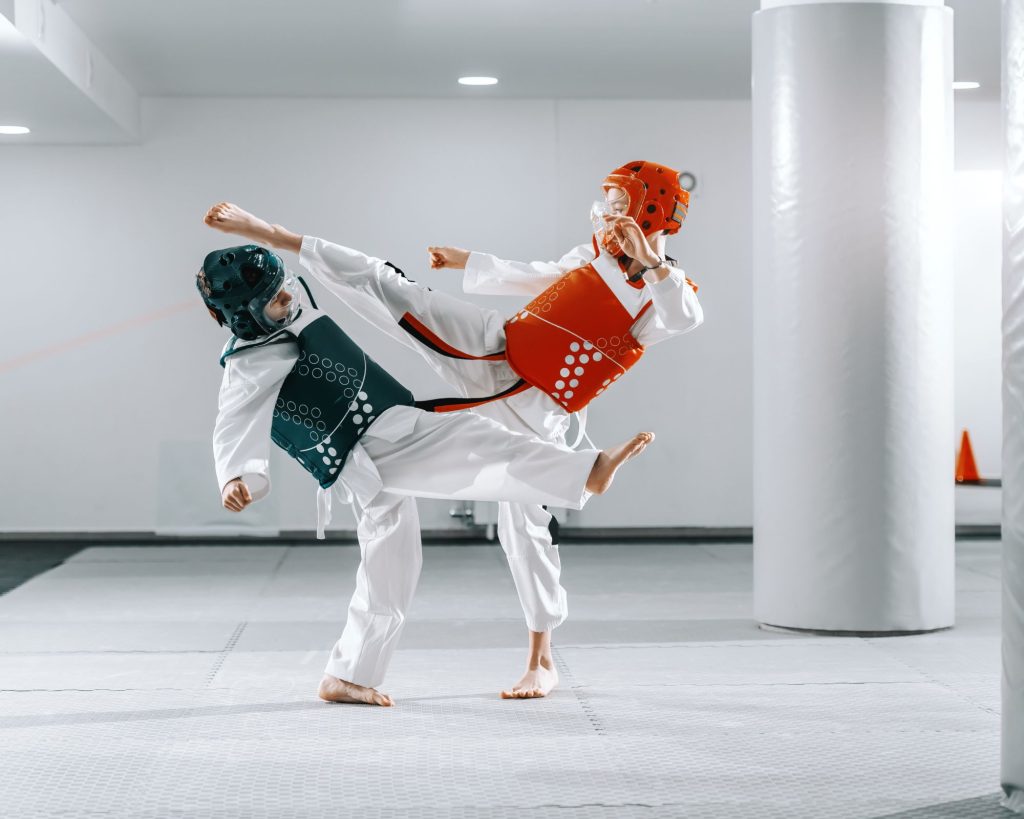
Taekwondo is a Korean martial art that emphasizes kicking and punching techniques. It is one of the most popular martial arts in the world, with millions of practitioners worldwide.
Taekwondo is often practiced as a sport, but it can also be used for self-defense. The word “taekwondo” literally means “the way of the foot and fist.”
Taekwondo is characterized by its fast and powerful kicks. Although it's a fairly recent martial art, it is believed to have roots in the ancient tribes of Korea, who used it for hunting and combat.
Taekwondo was formalized as a discipline in the 1950s, and it has since spread to many other countries.
There are four main styles of Taekwondo: Traditional, World Taekwondo, ITF, and ATA style. Taekwondo competitions are governed by the World Taekwondo Federation (WTF), which sets the rules for sparring and other aspects of the sport.
Taekwondo training typically includes a combination of physical conditioning, technique drills, and sparring.
Students usually progress through a series of colored belts as they learn and master new techniques. The black belt is the highest rank in taekwondo, and achieving this rank requires dedication and hard work.
Whether you’re interested in taekwondo for sport, self-defense, or simply as a way to stay fit, this martial art can be an enjoyable and rewarding experience. With its emphasis on kicking techniques, taekwondo is unique among martial arts, and its popularity continues to grow around the world.
Another thing I think is important to look at is the different rankings and levels in each art. if you are looking to take up either Aikido or Taekwondo, whether as a hobbyist or to compete, you need to understand the different levels of proficiency and what is required for testing and ranking.
Aikido Rankings & Levels
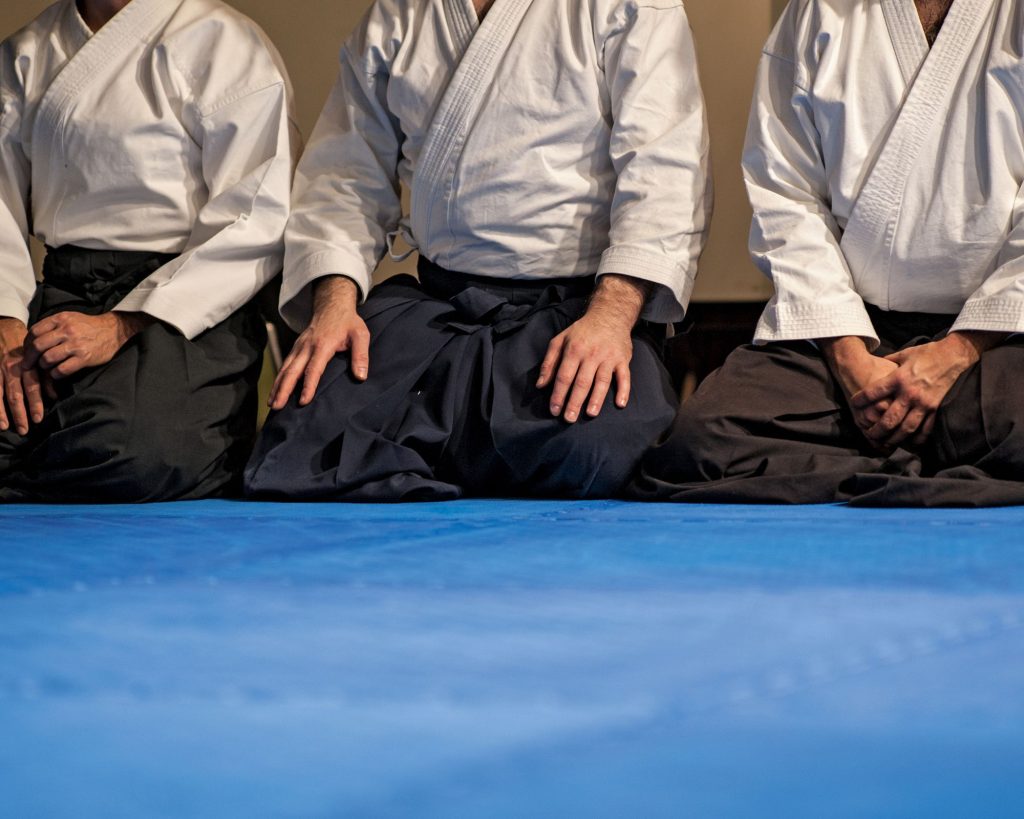
Aikido is a discipline that has many different levels, each represented by a different colored belt. The first level is white belt, which is for beginner students. Once you have mastered the basics of Aikido, you can move on to the blue belt, which is for intermediate students.
And finally, once you have mastered the art of Aikido, you can become a black belt, which is the highest level.
There are three degrees as a black belt holder: 1st dan, 2nd dan, and 3rd dan black belt. In order to achieve each of these degrees, you must pass a test that proves your mastery of Aikido.
There are also other ranks and colors that exist outside of the traditional ranking system. In some Western Aikido schools, there are more ranks added in between 1st dan and 2nd dan.
These ranks can be any combination of colors, and it allows for students to be promoted at a more gradual pace and helps to distinguish between students of different ranks.
Taekwondo Rankings & Levels
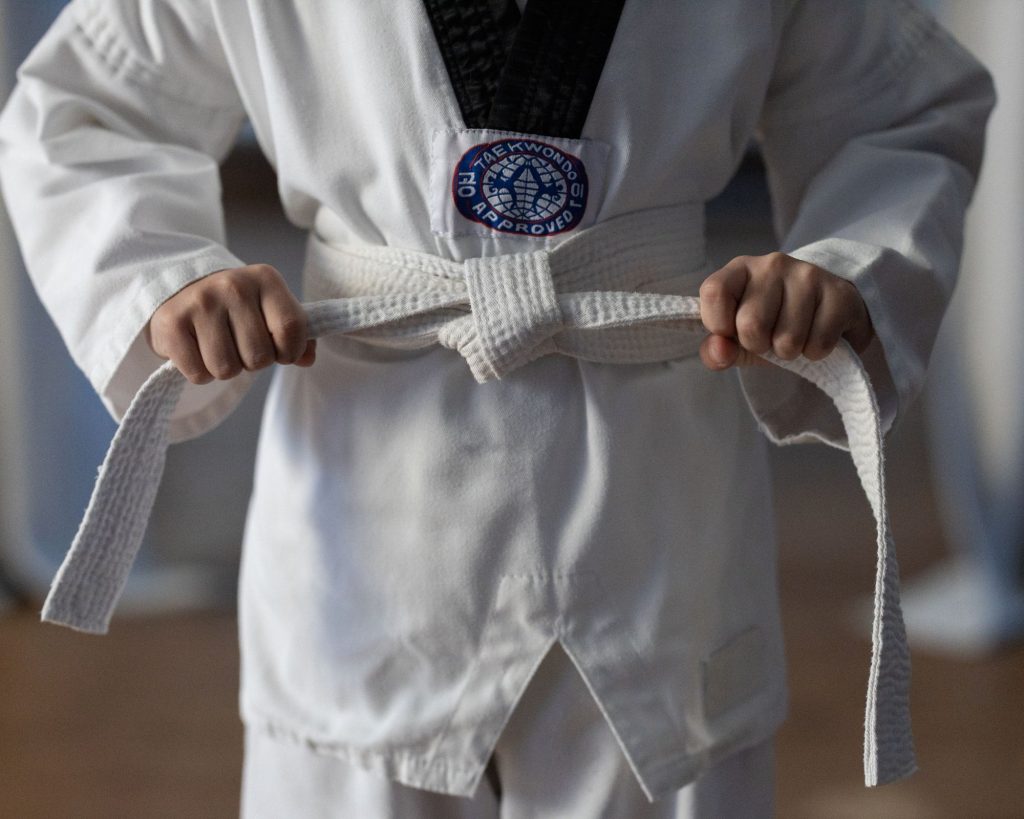
The rank system in Taekwondo is fairly complex, with 10 ranks ranging from 10th dan (white belt) to 1st dan (black belt). There are also a number of higher ranks called "master" ranks which are not awarded by most organisations.
Promotion between the ranks is usually based on a combination of time served and ability, with black belts often required to pass exams in order to be promoted to the next rank.
In some organisations, however, a black belt can be promoted straight to a master rank without having to go through all the lower ranks.
There are two main Taekwondo organisations--WT and ITF--and they have different standards when it comes to belts.
The WT organisation has 11 ranks, where belt colors are: white (11th dan), yellow, orange, green, purple, blue, blue and black, brown, brown and black, red, red and black, and black (1st dan).
In the ITF organisation, there are only 10 ranks, with the same belt colors as in the WT organisation. The difference is that the ITF organisation doesn't have a rank of brown and black – instead there is a rank of "red belt".
So overall, there are 21 different rank levels in Taekwondo: 11 in the WT organisation and 10 in the ITF organisation.
Aikido Vs. Taekwondo Attire
This section simply compares the clothing and uniforms that practitioners wear in combat.
Aikido Attire:
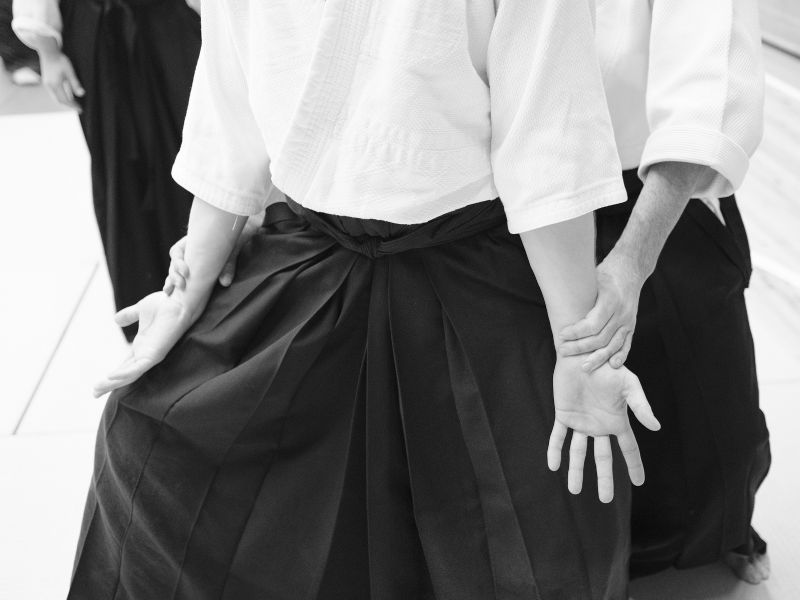
Most aikido practitioners wear a white dogi, or “uniform.” The dogi is a loose-fitting cotton kimono with a belt. In some schools, aikido students also wear hakama, which are pleated trousers that are tied at the waist and fall below the knee.
Male practitioners often don white tabi (socks), while female practitioners often wear white zori (wooden sandals). Some people also choose to practice without any clothes on in order to better feel their body and movements, but this isn't all too common.
Taekwondo Attire:
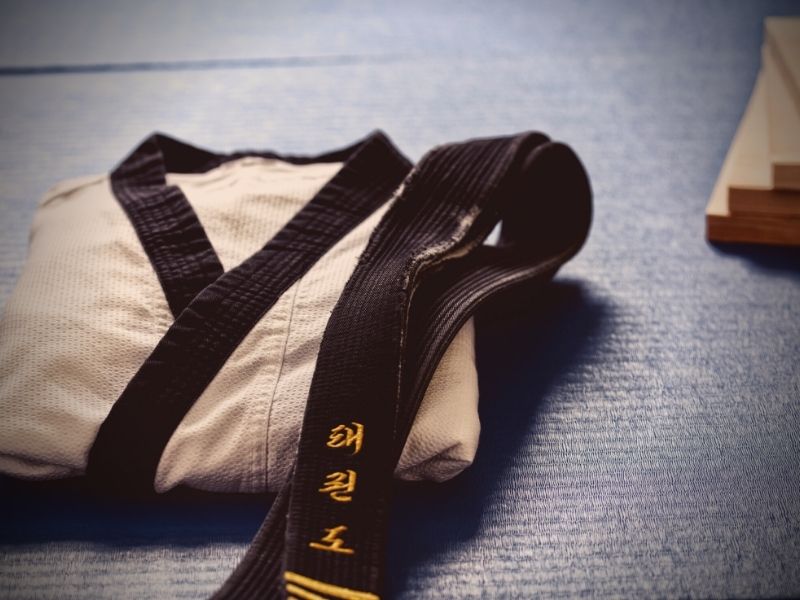
The traditional uniform for Taekwondo practitioners is a dobok. The dobok is white and consists of a jacket and pants. Most Taekwondo schools also require the use of Taegeukgi (Korean flag) belt, though there are some who do not.
In addition to the regular uniform, many Taekwondo schools also require the use of a head protector, chest protector, and padded gloves during practice.
What A Typical Aikido Training Session Looks Like

A typical Aikido practice session usually starts with a bow. This is a sign of respect for the dojo, the other students, and the instructor. The etiquette of aikido extends beyond just the bow, though. One must always be respectful, appreciative, and protective of all beings.
This attitude must be carried throughout the entire practice session.
Physical strain, whether during conditioning or in sparring against others, is part and parcel of Aikido. As such, practitioners need to maintain good manners and a positive attitude whenever they're in aikido class.
Aikido teaches you how to handle violence, but it still ultimately strives for peace, so never let your ego get in the way during your training.
Also remember that non-resistance is an essential element of proper aikido technique execution. Intercepting, deflecting, and redirecting an attack utilize the momentum and inertia of the attack.
Note that non-resistance does not mean being passively overpowered by the attack. But if you can avoid physical conflict, then you absolutely should.
It is also always important to maintain good posture and a relaxed body. Good posture includes maintaining your balance and keeping your center of gravity low. This helps you to be more aware of your surroundings and to respond more effectively to any situation.
Maintaining a relaxed body allows you to move more freely and makes it less likely that you will be thrown off balance by an attacker.
Similarly, be sure to focus on your breathing during aikido practice. This helps to calm and focus the mind, allowing for better decision making and execution of techniques.
Next, warm-up exercises are often done, including stretches and rolling or breakfalls (ukemi). These help to prepare the body for physical activity and prevent injury.
Following warm-ups, the instructor will lead the class through various aikido techniques and movements. These often involve practicing with a partner, called uke-nage (uke being the attacker, nage being the defender).
Practice with a spirit of cooperation, not necessarily competition. The goal is to mutually improve each other's technique and understanding of aikido principles, not to overpower or dominate the other person.
The practice session may also include weapons training, using a wooden sword (bokken) and wooden staff (jo). Weapons techniques often involve similar principles to those practiced with empty-handed techniques, but provide another layer of complexity and challenge.
What A Typical Taekwondo Training Session Looks Like
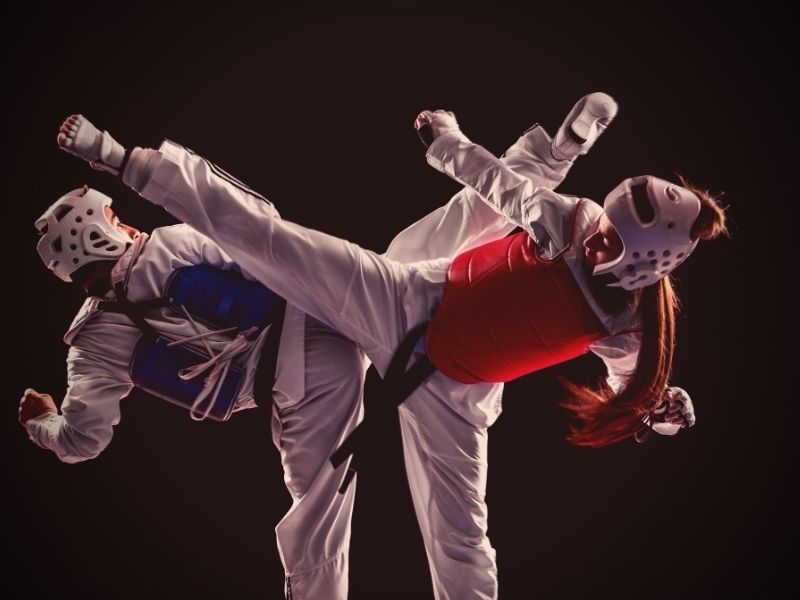
A typical Taekwondo practice session begins with a warm-up that includes stretching and light calisthenics, followed by a series of kicks and punches. The focus then turns to practicing techniques on a heavy bag or sparring with a partner.
The session ends with cooling down and review. Throughout the session, practitioners maintain a spirit of discipline and respect. Taekwondo is an excellent way to improve physical fitness, flexibility, and coordination, as well as an effective form of self-defense.
As such, it is practiced by people of all ages and abilities--as it should be. Whether you are looking to get in shape or learn how to defend yourself, Taekwondo is an excellent choice.
If the last few sections have been a bit full-on or a bit too technical, you will like this next section! Why? Because who doesn't love a good martial arts flick? Both Aikido and Taekwondo have been featured in a number of films and TV shows, so if you want to learn more about them, then entertain yourself with the following 👊
Aikido Movies

These are some of the top movies and shows with Aiki Jujutsu in them:
- The Bourne Identity (2002)
- Kill Bill: Volume 1 (2003)
- Ong Bak (2003)
- Daredevil (TV series, 2015-2018)
- The Wolverine (2013)
- Arrow (TV series, 2012-2020)
- John Wick (2014)
- 13 Assassins (2010)
- The Raid (2011)
And some movies that have Taekwondo in them that you may not even have noticed…
- The Karate Kid (1984)
- The Matrix (1999)
- Crouching Tiger, Hidden Dragon (2000)
- Captain America: The Winter Soldier (2014)
- Kung Fu Panda (2008)
Both of these martial arts have been used in countless action movies and TV shows, often providing dynamic fight scenes and impressive stunts.
Conclusion: Aikido Vs. Taekwondo
I hope you now have a deeper understanding of Aikido and Taekwondo. In all truth, it is not about which discipline is "better" as they each have their pros and cons.
If you do plan on starting classes for either, please check out my other related posts, as I have tried my best to answer all the FAQs related to the art.
Feel free to share this post and any graphics you like, and of course, if you have any questions or thoughts, drop them below or shoot me an email, and I will be happy to assist 🙂
[author-box-jpx-fitness]
